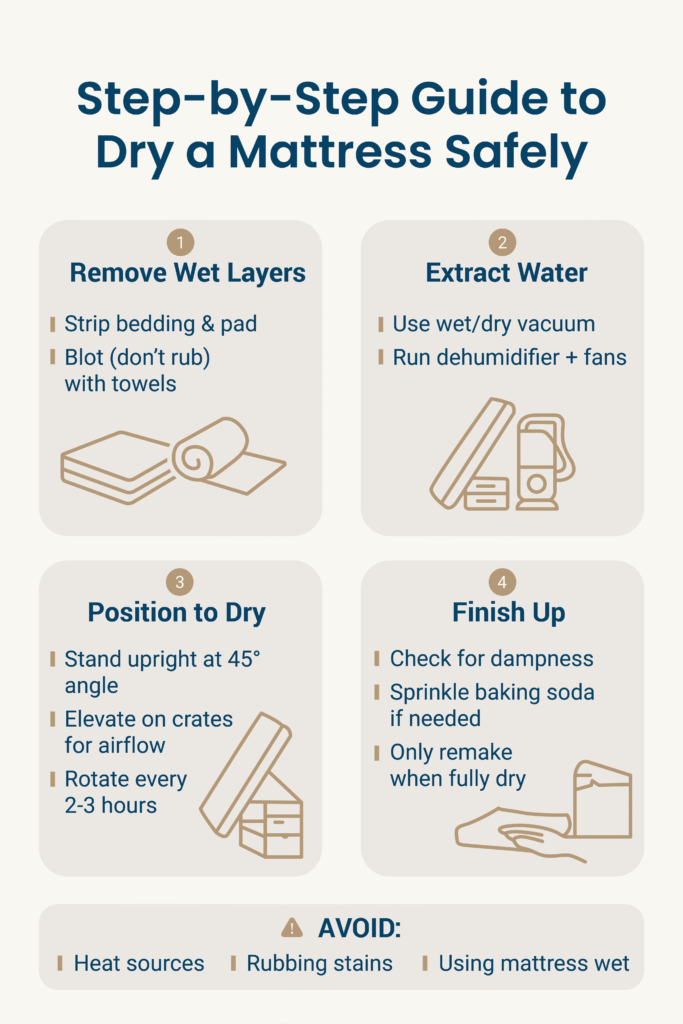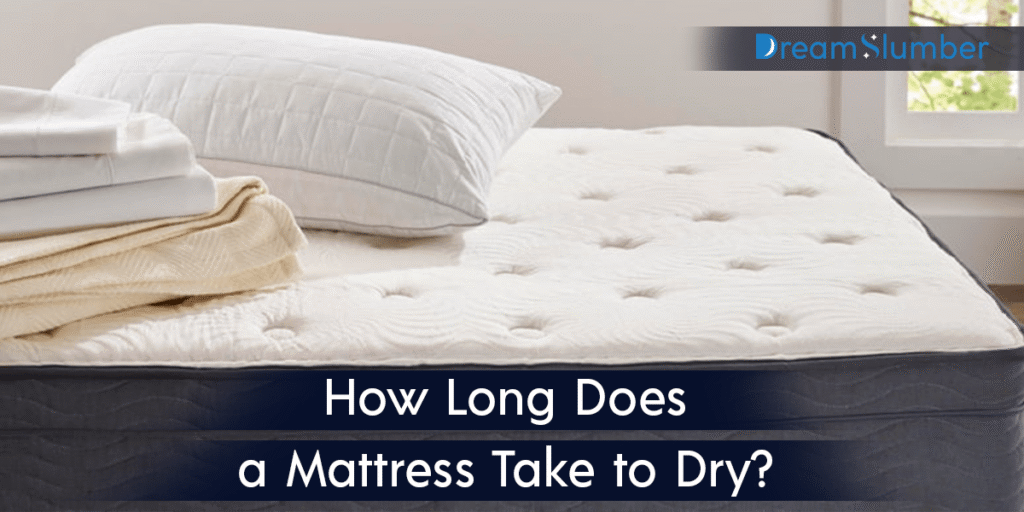When you purchase through our links, we may earn a commission at no extra cost to you. As an Amazon Associate, DreamSlumber earns from qualifying purchases. Learn more.
Did you spill something on your mattress? Maybe your pet had an accident? You’re wondering how long does a mattress take to dry. A wet mattress hurts your sleep quality and shortens its life. Wet mattresses draw in 38% more dust mites and last 2-3 years less than dry ones. In 2025, with mattresses costing $1,000-$2,000, knowing the right mattress drying time is vital.
Drying time depends on your type of mattress, how thick it is, and how you dry it. Innerspring mattresses can dry in 8 hours, while memory foam might need up to 72 hours. Let’s look at what affects drying time and how to speed it up.
Why Proper Mattress Drying Matters for Sleep Health
A damp mattress can hold up to 10 million dust mites. It becomes a place where bacteria and allergens grow, leading to serious health issues. When excess moisture stays in your mattress, it causes:
- Mold and mildew growth
- More dust mites
- Bacterial growth
- Unpleasant odors
- Damage to mattress layers
- Potential health risks to people who sleep on it
These problems cause allergies, respiratory issues, and skin rashes. They ruin your sleep and damage your mattress beyond repair. The health risks of damp mattresses are the worst for children, older adults, and people with weak immune systems.
How Long Does a Mattress Take to Dry? Key Factors
Mattress Material Comparison
Your type of mattress greatly affects drying time:
| Mattress Type | Average Drying Time | Drying Characteristics |
| Memory Foam | 24-48 hours | Holds excess moisture, dries slowly |
| Latex | 12-24 hours | Latex layers resist water, dry faster |
| Innerspring | 8-16 hours | Better air flow through mattress fibres |
| Hybrid Mattresses | 16-36 hours | Varies based on foam thickness |
| Organic/Natural | 10-20 hours | Natural mattress fibres dry faster |
Memory foam mattresses are the hardest to dry. Their dense structure traps water deep in the mattress layers. Hybrid mattresses dry unevenly. The coil section dries faster than the foam layers.
Time Frames for Different Moisture Situations
The water source and amount affect drying time:
- Light surface dampness: 4-8 hours
- Moderate spills: 6-24 hours
- Deep moisture: 24-48 hours
- Complete soaking: 48-72 + hours
To return to its original condition, all mattress layers must be completely dry, not just the surface.
Environmental Factors
Your environment plays a big role in drying:
- Proper air circulation: Cuts drying time by 30-40%
- Humid climate: Adds 50-70% to drying time
- Room temperature: Best at 70-80°F (21-27°C)
- Seasons: Winter drying takes 25-35% longer

Step-by-Step Guide to Dry a Mattress Safely
Step 1: Initial Water Removal
- Strip all bedding and remove the mattress pad
- Check for water stains and damp spots
- Blot (don’t rub) with clean towels or dry towels
- Replace wet towels with dry ones often
- Use absorbent cloths to press out excess water
Step 2: Use Proper Equipment
For the best results, use:
- Wet/dry vacuum with upholstery attachment
- Standing fans for air movement
- Dehumidifier set to the highest setting
- Clean cloth for ongoing blotting
Step 3: Position for Maximum Airflow
Create proper air circulation around the mattress:
- Stand upright against a wall (45° angle)
- Raise it on a dry, stable surface
- Use plastic crates underneath for air flow
- Rotate every 2-3 hours for even drying
- Keep away from uneven surfaces
Step Moisture Absorption Techniques
Baking Soda Treatment
Baking soda works well for absorbing excess moisture:
- Sprinkle 1-2 cups evenly on damp areas
- Add 10-15 drops of tea tree oil (a natural sanitizer)
- Let it sit for 2-6 hours at least
- Vacuum thoroughly with an upholstery attachment
This method absorbs moisture while removing unpleasant smells.
Alternative Absorbents
When dealing with excess moisture, try these options:
- Kitty litter: Place unused clay-based litter in a thin layer
- White vinegar solution: Mix equal parts vinegar and water in a spray bottle
- Cornstarch: Works well for smaller, damp spots

Preventing Mold and Health Issues
Mold starts growing in as little as 24-48 hours in damp conditions. To prevent mold:
- Apply fabric-safe disinfectant after drying
- Watch for signs of moisture even after the surface seems dry
- Check for musty odor or dark spots
- Use a clean cloth with white vinegar to treat suspect areas
- Consider UV sanitizer mattress treatments for deep cleaning
Professional Options and When to Replace
When to Call Professional Cleaners
Contact professional cleaners or a restoration specialist if:
- Black water or sewage got on your mattress
- Mattress has been wet for over 24-48 hours
- You see white fuzz or dark spots (signs of mold)
- Unpleasant smell remains after drying attempts
- You have a valuable or warranty-covered mattress
Professional mattress cleaners use special equipment like hot water extraction machines and industrial dehumidifiers.
When Replacement is Necessary
Consider replacing your mattress if:
- It’s been exposed to contaminated water
- Visible stains remain after cleaning
- Stubborn stains won’t come out with treatment
- White fuzz or mold appears in multiple areas
- The mattress has been wet for extended periods
- Structure shows permanent damage or deformation
- Unpleasant odors remain after thorough cleaning
Preventative Measures for Future Protection
Protect your investment with these preventative measures:
- Use a quality waterproof mattress protector or waterproof cover
- Consider a waterproof mattress pad for extra protection
- Fix any leaky roof or plumbing issues promptly
- Check your bed frame regularly for stability
- Keep humidity control devices in bedrooms in humid climate areas
Also Read:
- Do Mattress Covers Make You Sweat?
- What Is a Cold Foam Mattress?
- Does a Waterproof Mattress Protector Make You Sweat?

Frequently Asked Questions
How does excess moisture affect different mattress layers?
Excess moisture seeps from the top down, affecting each layer differently. Surface fabrics dry in 4-8 hours, while inner mattress layers can stay damp for 24-48 hours. This damages mattress fibres and can cause permanent damage.
Can waterproof mattress protectors prevent damage from accidental spills?
Yes, a good waterproof mattress protector creates a strong barrier against spills and prevents moisture build-up. These protectors let air flow while stopping excess water from soaking into mattress layers.
What are the potential health risks of sleeping on a mattress with excess moisture?
Potential health risks include respiratory issues, allergic reactions, skin irritation, and worse asthma symptoms. Damp mattresses cause 68% more nighttime symptoms and expose sleepers to 3.2 times more mold spores.
How do you remove unpleasant odors from a mattress after water damage?
To remove unpleasant odors, use baking soda for 12-48 hours, then vacuum fully. A white vinegar solution in a spray bottle neutralizes foul odors. You may need professional odor removal mattress treatments for stubborn, funky smells.
What’s the best way to restore a mattress to its original condition after water stains?
To restore the original condition after water stains, blot with clean towels, treat with enzyme cleaner, apply baking soda for 6-8 hours, vacuum thoroughly, and allow complete drying for 24-48 hours with proper air circulation.
How long should I wait before using my mattress after cleaning with warm water?
After cleaning with warm water, wait at least 12-48 hours before using your mattress. Memory foam mattresses need longer drying times (24-48 hours), while innerspring mattresses might be usable after 8-16 hours if completely dry.
How do hybrid mattresses differ from memory foam when drying?
Hybrid mattresses dry more unevenly than pure memory foam. The innerspring section dries in 8-16 hours, while the foam top may take 24-48 hours. This uneven drying can trap moisture between mattress layers.
Can white vinegar help eliminate unpleasant smells from a damp mattress?
Yes, white vinegar effectively removes an unpleasant smell from a damp mattress. Mix equal parts vinegar and water in a spray bottle, lightly spray affected areas, and let dry completely to eliminate funky smells.
What signs indicate bacterial growth in a mattress with excess moisture?
Signs of bacterial growth include ongoing unpleasant odors, dark spots, discoloration, a slimy feeling on the surface, and worse allergy symptoms. Excess moisture left for over 24-48 hours creates perfect conditions for bacteria.
How does a humid climate impact mattress drying time?
A humid climate increases drying time by 50-70% by slowing moisture evaporation. Dehumidifiers are essential in high humidity, and memory foam may dry for extended periods of up to 72 hours in humid conditions.
Are professional cleaners worth hiring for severe water damage to mattresses?
Yes, professional cleaners are worth the cost for severe water damage. They use hot water extraction cleaning techniques and special equipment to remove excess water from deep inside mattress layers that DIY methods can’t reach.
Conclusion: Prioritize Dryness for Lifelong Comfort
You now know how long does a mattress take to dry and why proper care matters. Your innerspring mattress needs about 8 hours to dry, while your memory foam mattress requires up to 72+ hours. Act quickly when spills happen and choose drying methods that match your specific type of mattress. Wet mattresses create health risks and damp mattress problems that harm your well-being. Your family deserves a clean, dry sleeping surface that lasts its full lifespan. Smart homeowners use organic mattress protectors and act right away when moisture appears. You can use methods like sunlight drying mattress techniques and dehumidifiers to protect your mattress investment and enjoy years of healthy, comfortable sleep.


